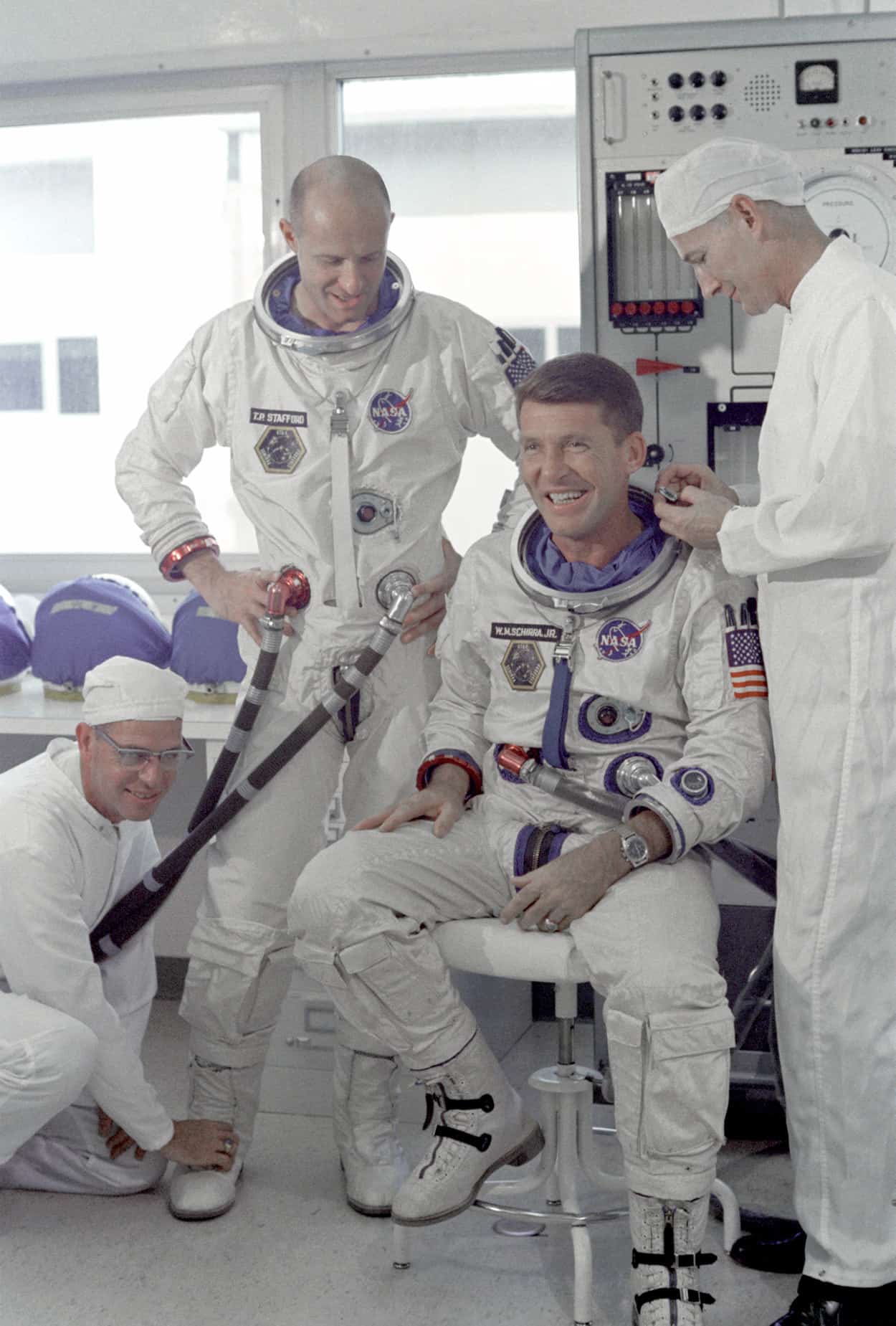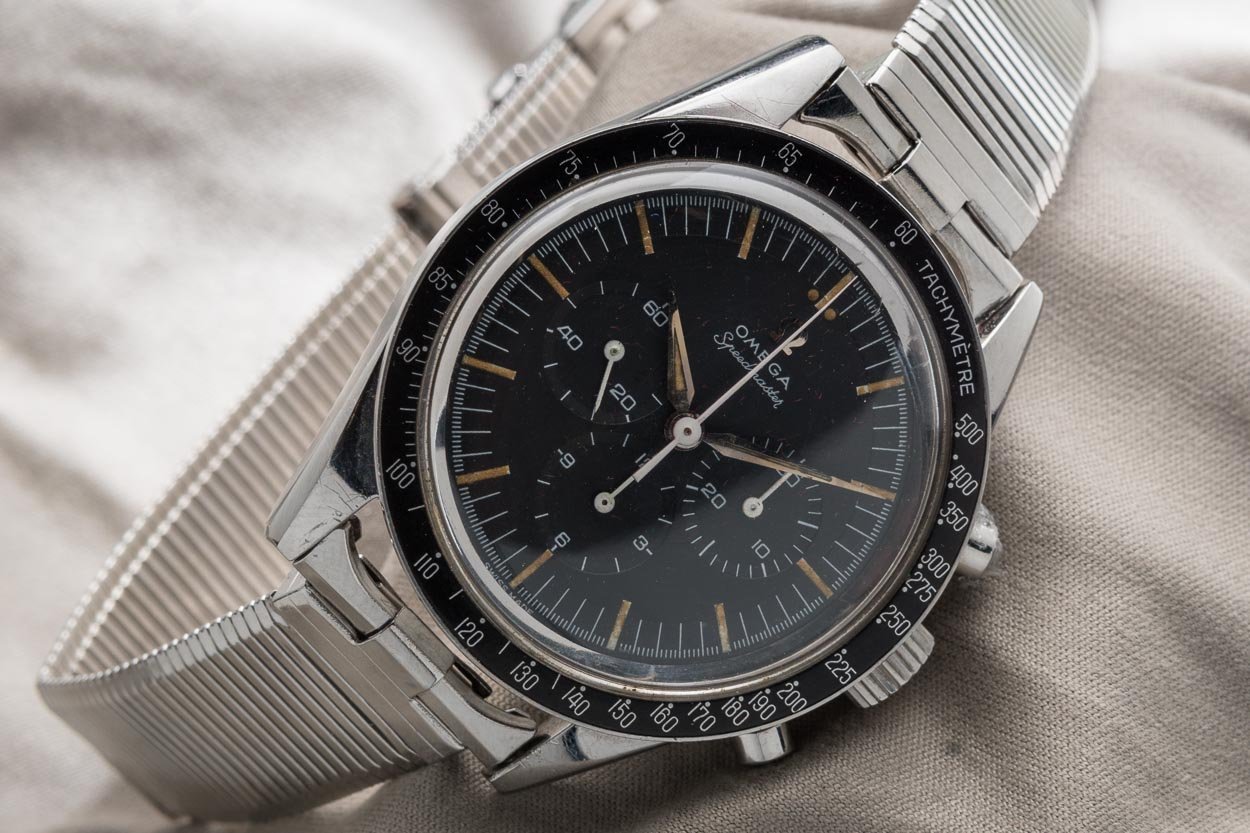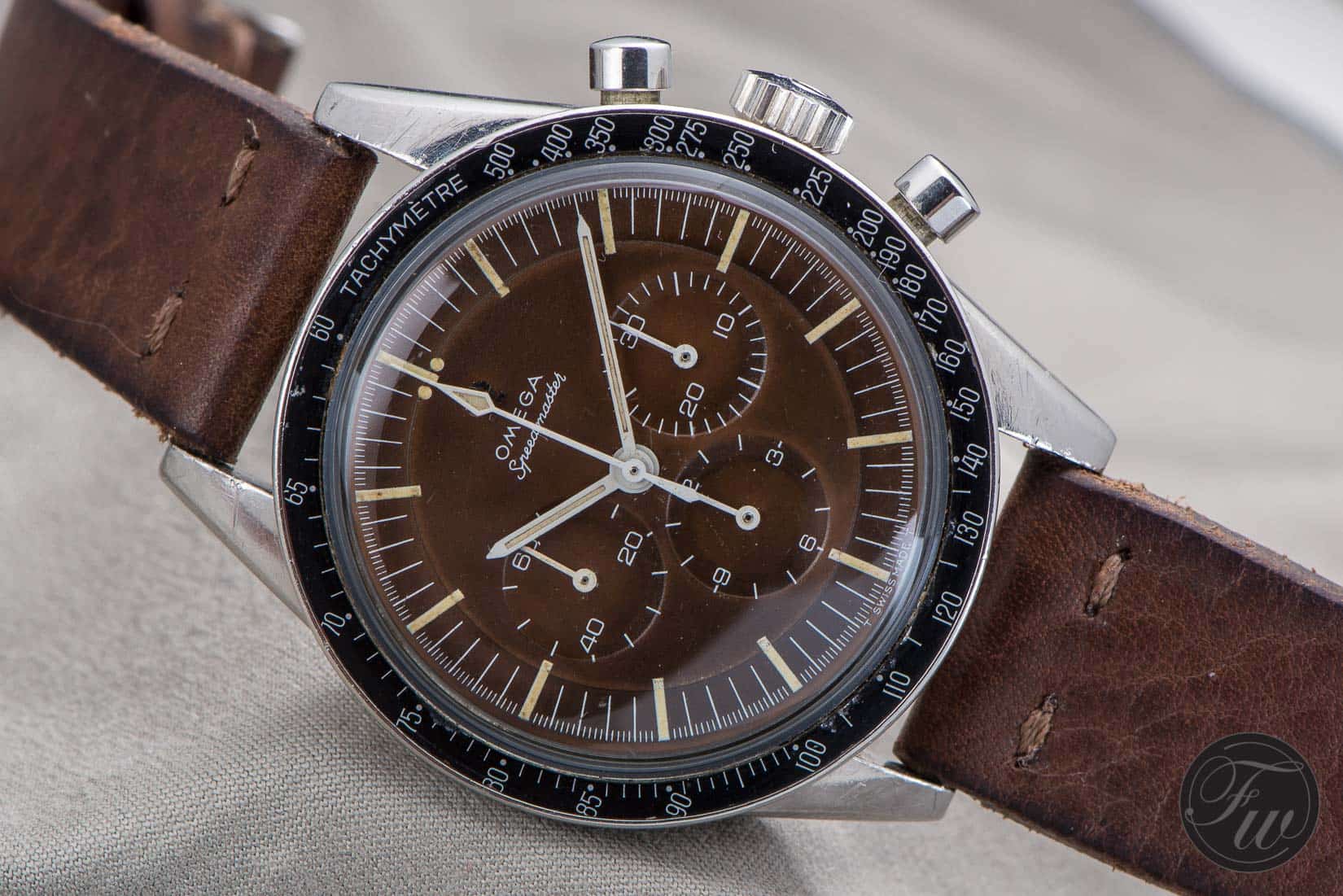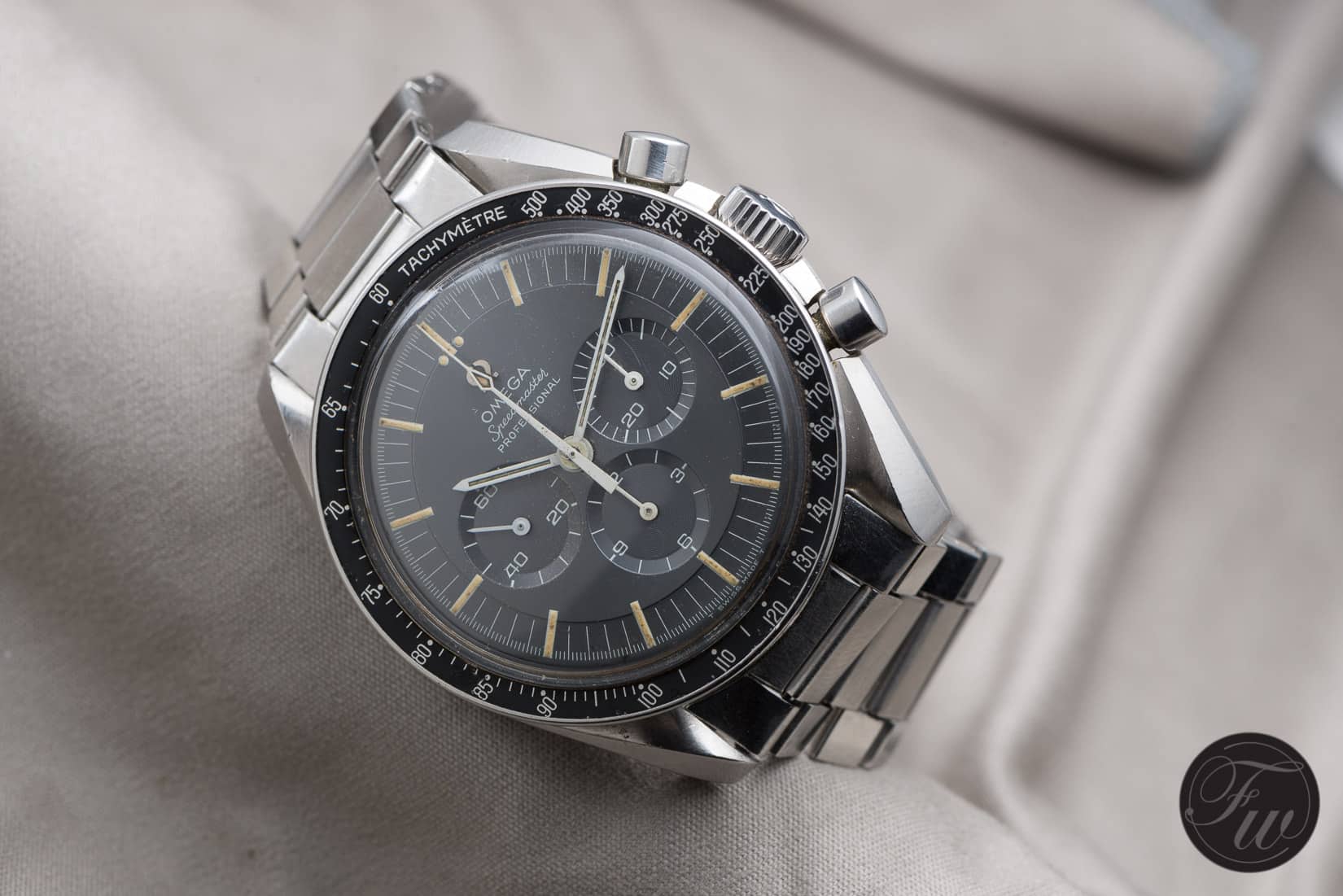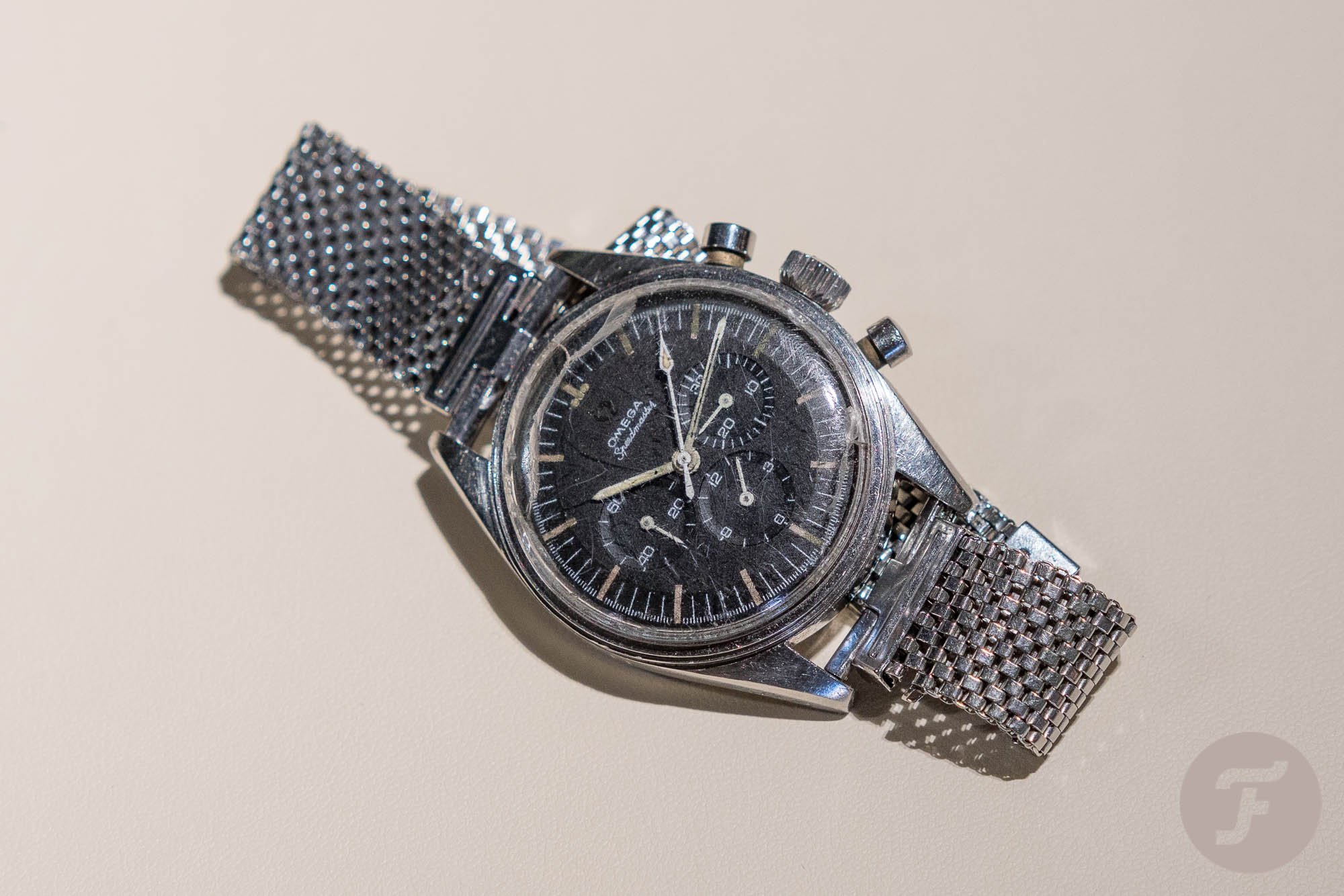How the Speedmaster became the Moonwatch
This year we celebrate the 50th anniversary of the Moon landing, and with that, also the 50th anniversary of the Speedmaster Professional as the Moonwatch. Time to recap once more how the Speedmaster became the Moonwatch.
Exactly 50 years ago, on July 16, the Saturn V rocket was on its way to the Moon (and back) as part of the Apollo XI mission. On board were fearless astronauts Neil Armstrong, Buzz Aldrin and Michael Collins. On their wrists, but probably the least of their concern, the Omega Speedmaster Professional.
On July 20th 1969, the Apollo 11 Lunar Module put astronauts Neil Armstrong and Edwin “Buzz” Aldrin on the surface of the Moon. Michael Collins stays in the Command Module. On July 21st, at 2:56 UTC, Armstrong set foot on the Moon and spoke his famous words (with or without the ‘a’). Not much later, Buzz Aldrin followed him. On his wrist, the Omega Speedmaster Professional – from that moment on, the ‘Moonwatch’. Until a few years back, it wasn’t known which exact Speedmaster references were used on the Moon.
Omega has an active museum and archives team, and in the last couple of years, they have done a massive amount of research on the Moonwatch topic. Let’s start by saying that the story of purchasing a few watches at a retailer in Houston (Corrigan’s) is just that: a story. It’s a story that we would have assumed to be neglected in the meantime because former NASA engineer James Ragan explained several times what the deal was. There was a proper tender process for selecting the chronograph for astronauts. So for once and for all, the Houston jeweller story is nonsense.
But let’s step back a little, as the story starts a bit earlier on. A few years before the Omega Speedmaster became the Moonwatch, astronauts Walter Schirra and Gordon Cooper purchased a couple of Speedmasters for use during flights. This was in 1962 already, and both Schirra and Cooper bought a couple of Speedmaster reference CK2998 watches. The CK2998 is the second reference of Speedmaster watches, not counting some of the sub-references (CK2915-1 to CK2915-3). Where the CK2915-3 can be considered a transitional model with its black bezel and alpha-shaped hands, the CK2998 was the new reference with all these features.
Speedmaster in Space – Sigma 7
On board of the Sigma 7, during the Mercury-Atlas 8 mission (October 1962), astronaut Walter Schirra was wearing his Speedmaster CK2998. Schirra was the only astronaut to fly all three of NASA’s early manned spacecraft (Mercury, Gemini and Apollo). In 2012, Omega commemorated the first Speedmaster CK2998 being used in space with a “First Omega in Space” model. Today, similar models are available in Omega’s Sedna gold and as a modern reinterpretation of the CK2998 with a 2016 and 2018 Speedmaster CK2998 limited edition.
Below, an image of Schirra wearing his CK2998 watch right after the Mercury-Atlas 8 mission. He is talking to the President onboard US Navy ship USS Kearsarge (image via one of our readers, image by NASA).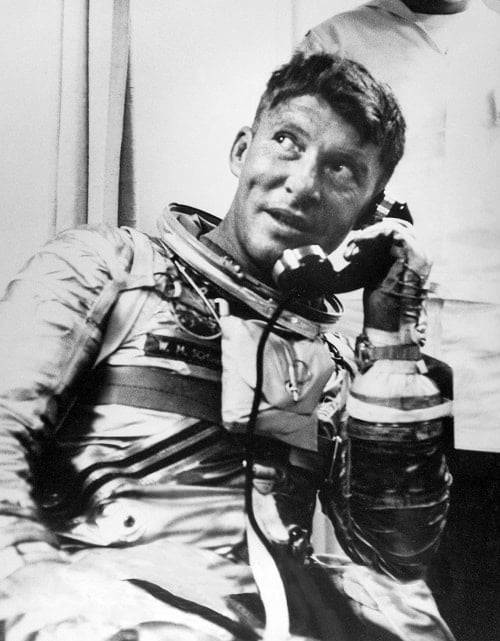
Below, another image from the NASA archives where you can see Schirra wearing his Speedmaster. This picture was taken during the suiting up exercise for Gemini 6, in 1965, showing Schirra still wearing his Sigma 7 Speedmaster.
And last but not least, the actual Speedmaster that was worn by Schirra and pictured above. This watch was present during one of our Speedy Tuesday events, where Omega brought it in from their museum. If you want to know more about Wally Schirra and his memories of the space program (and watches), you might be interested in the interview we published a while ago here.
A Watch For Gemini and Apollo Missions
As can be seen in this excellent report on Purist Pro, there was a need for officially tested and certified watches. All equipment used on the Mercury program was being evaluated, and NASA hired a team for the procurement of equipment for Gemini and Apollo missions. This included a watch suitable for training and flights, of course. One of the persons that were hired for this job at the time was NASA engineer James “Jim” Ragan. Ragan was in charge of the selection procedure and testing of the chronographs, but also had an essential role in selecting the cameras for astronauts. And let’s not forget that it was Ragan who reached out to Paul Fischer for a pen with a pressurised ballpoint. Known today as the Fisher space pen.
Chronograph Selection
NASA’s Operation Director Deke Slayton wrote an internal memo to the procurement department on September 21st 1964, making his requirements clear for such a watch with chronograph functionality. So, Jim Ragan created a request for proposal which stated that at least six watch brands should provide chronographs for NASA’s purposes.
Below, an image of Jim Ragan (wearing his X-33 Skywalker) taken during our Speedy Tuesday event in Hong Kong where he talked about the selection process of the Moonwatch.
Omega, Rolex, Longines and Hamilton
On official documentation can be seen that the delivery of those chronographs should take place before October 24th 1964. That was only a month since the internal memo by Deke Slayton. Remember that it was an era without e-mail, so going back and forth with letters was already consuming quite a bit of time. To be sure, Ragan sent out his request for proposal to 10 different watch brands. Only four brands responded to NASA’s request, which were: Rolex, Longines-Wittnauer, Hamilton and Omega. Ragan still had to chuckle when he told this, but Hamilton sent a pocket watch instead of the chronograph wristwatch he asked for. Unbelievable.
The famous Valjoux 72 caliber movement powered both the Rolex and the Longines-Wittnauer. Omega’s Speedmaster, as you know, was powered by the caliber 321 movement. Omega’s enhanced version of the Lemania C27 CHRO 12 movement. For a long time, it wasn’t known which exact Rolex and Longines-Wittnauer were tested, but these records have been made public during one of our Speedy Tuesday events earlier this year. Longines-Wittnauer submitted their reference 235T, and Rolex sent their reference 6238 chronograph.
- The Wittnauer 235T
- Rolex 6238 – photo courtesy of Phillips
Since in the end, only a few brands responded, Ragan asked all of them to provide three watches. Omega provided NASA with their Speedmaster reference 105.003, Rolex sent their 6238 and Longines-Wittnauer a 235T.
Omega Speedmaster 105.003
The Omega Speedmaster 105.003 is considered to be the third generation of Speedmasters. This can be disputed, as there was a 105.002 reference between the CK2998 and the 105.003. However, that was more of a transitional model, as Omega decided to change their reference number system. The 105.003 had a new design regarding the hands, which were now white baton ones instead of the Alpha hands. The white baton hands were more legible.
This reference is the model that was tried and tested by NASA and got eventually qualified. Or ‘Flight Qualified for all Manned Space Missions’, as you see engraved in the case backs on later references.
11 Types of Tests
NASA designed a couple of tests for these watches, that weren’t meant to keep the watches in one part. These tests were designed to test the watches to destruction. In a relatively short period (of months), the following tests were performed on the watches:
1. High temperature
48 hours at a temperature of 160°F (71°C) followed by 30 minutes at 200°F (93°C). This under a pressure of 5.5 psia (0.35 atm) and relative humidity not exceeding 15%.
2. Low temperature
Four hours at a temperature of 0°F (-18°C).
3. Temperature-Pressure
Chamber pressure maximum of 1.47 x 10-5 psia (10-6 atm) with temperature raised to 160°F (71°C). The temperature shall then be lowered to 0°F (-18°C) in 45 minutes and raised again to 160°F in 45 minutes. Fifteen more such cycles shall be completed.
4. Relative humidity
A total time of 240 hours at temperatures varying between 68°F and 160°F (20°C and 71°C) in a relative humidity of at least 95%. The steam used must have a pH value between 6.5 and 7.5.
5. Oxygen atmosphere
The test item shall be placed in an atmosphere of 100% oxygen at a pressure of 5.5 psia (0.35 atm) for 48 hours. Performance outside of specification, tolerance, visible burning, creation of toxic gases, obnoxious odours, or deterioration of seals or lubricants shall constitute failure to pass this test. The ambient temperature shall be maintained at 160°F (71°C).
6. Shock
Six shocks of 40 Gs, each 11 milliseconds in duration, in six different directions.
7. Acceleration
The equipment shall be accelerated linearly from 1 G to 7.25 Gs within 333 seconds, along an axis parallel to the longitudinal spacecraft axis.
8. Decompression
Ninety minutes in a vacuum of 1.47 x 10-5 (10-6 atm) at a temperature of 160°F (71°C) and 30 minutes at 200°F (93°C).
9. High pressure
The equipment to be subjected to a pressure of 23.5 psia (1.6 atm) for a minimum period of one hour.
10. Vibration
Three cycles of 30 minutes (lateral, horizontal, vertical), the frequency of varying from 5 to 2,000 cps and back to 5 cps in 15 minutes. Average acceleration per impulse must be at least 8.8 Gs.
11. Acoustic noise
130 db over a frequency range of 40 to 10,000 Hz, duration 30 minutes.
Results
On March 1st 1965, the tests were completed. On June 1st 1965, the Omega Speedmaster 105.003 received the official qualification (not certification! A common misunderstanding, but NASA does not certify watches) for use during manned space missions. The other two brands failed (and stopped working during the test). The information that Petros Protopapas (Omega’s Head of Brand Heritage) showed during a Speedmaster event in Tokyo indicates that the Rolex 6238 failed the humidity test by completely stopping the movement and again it failed during the high-temperature test. The Longines-Wittnauer 235T failed the high-temperature test as well, as the crystal warped and disengaged.
At the end of March 1965, during the Gemini III missions, the new Speedmaster 105.003 was brought into space on the wrists of astronauts Virgil Grissom and John Young. Also in 1965, Edward White wore his 105.003 when performing the first American spacewalk during the Gemini IV mission.
The Moonwatch
So, the 105.003 is the Moonwatch? We are not entirely there yet. You should know that the Speedmaster 105.003 was in production for a long time, from 1964 till 1969. Meanwhile, Omega also introduced newer references, 105.012 and 145.012. NASA ordered their Speedmasters in four different batches, the last one in September 1968. The reason for this is that Omega introduced the newer caliber 861 movement for their Speedmaster chronographs. This would mean the rigorous tests needed to be performed all over again (which they did in 1978 for the Space Shuttle program).
The 105.012 and 145.012 had lyre lugs and crown guards as opposed to the straight-lugs Speedmaster 105.003. Also, the 105.012 and 145.012 had ‘Professional’ written on the dial. It is a common misunderstanding that ‘Professional’ was printed after the qualification on March 1st 1965. This is not the case. Already in 1964 Omega introduced the 105.012 with the ‘Professional’ word written on the dial.
Speedmaster 105.012
For a long time, it was a mystery which references were exactly used during the Apollo 11 mission. Or whether a caliber 861 Speedmaster ever was on the moon. In the meantime, a lot has changed, and Omega did great work together with NASA. For a few years, it is known that Edwin “Buzz” Aldrin wore a Speedmaster reference 105.012 – the first Speedmaster on the surface of the moon.
Legend has it that Neil Armstrong left his Speedmaster (also a 105.012) on board of the lunar module as the (Bulova) board clock malfunctioned. Aldrin’s watch later disappeared (in 1970), when it was sent off to the Smithsonian museum.
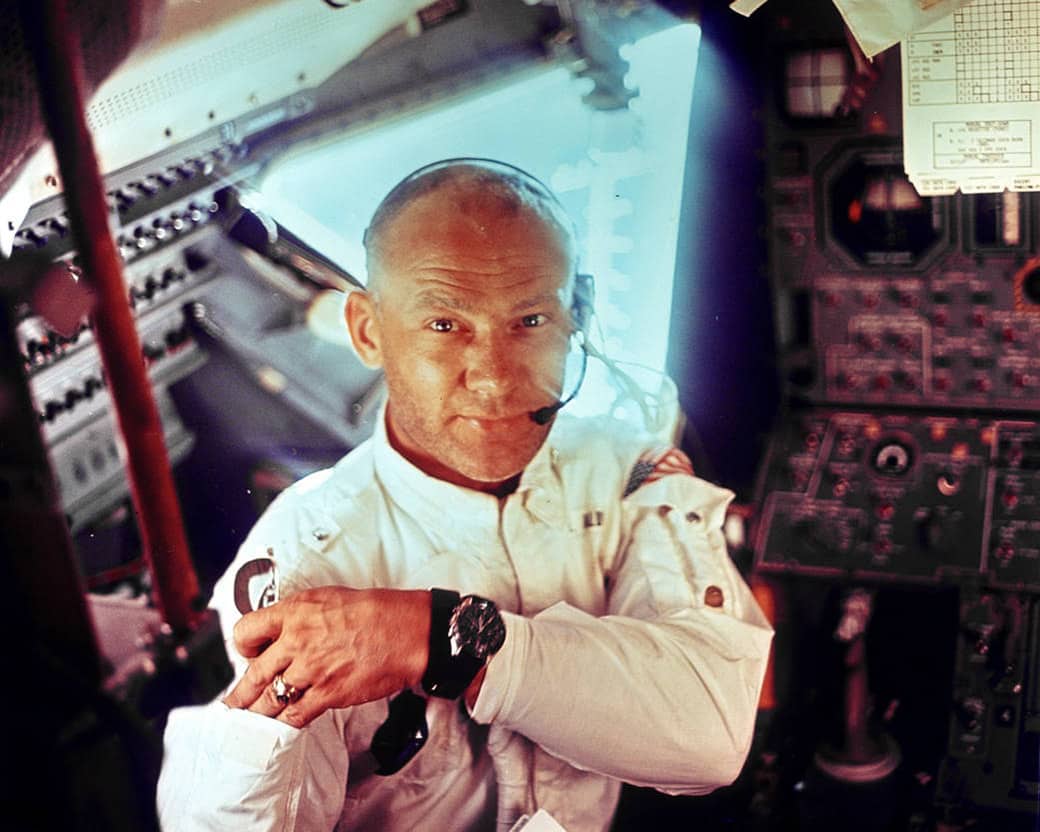
astronaut Edwin E. “Buzz” Aldrin, Jr. during the lunar landing mission. The picture was taken by astronaut Neil A. Armstrong
Speedmaster 145.012
Michael Collins, who remained in the Command Module of the Apollo 11, was wearing a Speedmaster reference 145.012. So it did not make a trip to the surface of the Moon that first time. During the third mission where astronauts set foot on the Moon, Apollo 14 astronaut Alan Shepard was wearing the Omega Speedmaster 145.012. The 145.012 was in production from 1967 to 1969 and had a new design for its pushers. The pushers of the 145.012 were screwed into the case and had slightly larger caps. It is the last reference to have the column-wheel chronograph caliber 321 movement.
Now, you would probably like to know the exact case numbers from the Speedmaster watches of Aldrin, Armstrong and Collins. From Aldrin, it is believed to be the Speedmaster 105.012-65. Armstrong’s watch was definitely a 105.012-65, and Collins was wearing the 145.012-68 (yes, a -68!!).
The Third Moonwatch Reference
Very important: as mentioned earlier, the Speedmaster 105.003 was also issued to Apollo astronauts, as NASA had it in stock from the original procurement. On some of the six missions that had successful landings on the Moon, the 105.003 was also used by the astronauts. Below, the 105.003 as worn by Gene Cernan during his Apollo 17 mission in 1972: the Last Man on the Moon.
Moonwatch 50th Anniversary
Omega is known to celebrate things and often very properly! This year, Omega celebrates the 50th anniversary of their Moonwatch on several locations all over the globe. Our local event in Amsterdam was held on July 2nd, and we did a report here. But, what better way to celebrate the Moonwatch with two exceptional watches. A re-edition of the Speedmaster Professional Apollo XI 1969 BA145.022 and a new Speedmaster Professional in stainless steel and touches of (Moonshine) gold, based on the 105.012 case. We described both watches in detail on Fratello, click here for the Moonshine gold Speedmaster Professional (1014 pieces) and here for the stainless steel Apollo XI 50th anniversary edition (6969 pieces).
Of course, if you want something close to the Moonwatch, you need to go vintage. It is ranging from the 105.003 till the 105.12 and 145.012 references. These watches, in good condition, are becoming more challenging to find and make sure that you will do your homework. If you want a modern watch, that is close to the Moonwatch; you might want to read this article here.
Stick around this week, as we will have something very cool coming up this weekend for the Moon landing anniversary.
Also make sure to visit the official Omega website for more Moonwatch stories.
*This article was first published in 2016, but we updated text and images for publication in 2019.


